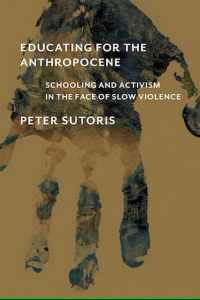In Educating for the Anthropocene, Peter Sutoris explores education around environmentalism and sustainability in Pashulok, India, and Wentworth, South Africa, two sites particularly impacted by the climate crisis. The book provides insightful analysis into how environmental education can be enhanced through radical imaginaries that enable students to realise their agency as political subjects, writes Josephine Becker.
Educating for the Anthropocene: Schooling and Activism in the Face of Slow Violence. Peter Sutoris. MIT Press. 2022.
 The open access book, Educating for the Anthropocene, captures the ethnographic research journey of Peter Sutoris in working with schoolchildren, teachers and environmental activists in Pashulok, India, and Wentworth, South Africa. Contextualised as ‘frontiers of the High Anthropocene’, the two research sites are set out as spaces for building a temporal arc of past, present and future.
The open access book, Educating for the Anthropocene, captures the ethnographic research journey of Peter Sutoris in working with schoolchildren, teachers and environmental activists in Pashulok, India, and Wentworth, South Africa. Contextualised as ‘frontiers of the High Anthropocene’, the two research sites are set out as spaces for building a temporal arc of past, present and future.
The sites of Pashulok and Wentworth are artifacts of colonial and racialised histories, in the present considered to be ‘behind their development trajectory’ of modernity whilst also being ‘communities of the future’ in experiencing accelerated environmental decay that most of the world does not yet face (10). This, according to Sutoris, makes them important places to study how young people are schooled in facing the accelerated realities of environmental and social crises. However, rather than considering the effectiveness of environmental and sustainability education (ESE), Sutoris problematises the depoliticisation of ESE that he witnesses in both locations, whilst seeking to explore how the political imaginaries of the young people are shaped.
Based on Hannah Arendt’s work on how ‘fast’ violence of the 20th century was enabled by totalitarian regimes through the bureaucratisation of large parts of the population, Sutoris argues bureaucratisation still plays a vital role in the continuation and ‘invisibilising’ of environmental destructive forces. Drawing on the work of Rob Nixon, the author makes fascinating links to show how the bureaucratisation and technocratisation of formal education lends itself to the state-sponsored social reproduction of ‘slow violence’. This refers to the destruction of the planet and its people through processes that are gradual and mostly invisible(-ised). It lacks the spectacle of blatant violence (8), although its accumulated effects result in such.
Sutoris complements his argument by tracing the sites’ histories, where colonialism, racism, apartheid and their legacies of poverty, segregation, unemployment and other violence, matched with local polluting industries (for example, factories and dams), strengthen depoliticising tendencies in ESE. Here, the ethnographic description captures insightful accounts of dilemmas faced at the schools, where the urgency of current survival struggles trump addressing the slow violence of climate disaster. For example, despite painful experiences, such as resettlement from local lands and air pollution from factories that have induced health issues, teachers had to prioritise teachings in line with neoliberal and development agendas that are considered to be the escape out of ‘fast’ violence (such as poverty) that saturates the daily lives of their students.

Photo by Elena Mozhvilo on Unsplash
Where ESE did take place, despite a lack of funding and teacher training, it was mostly concerned with environmental aesthetics and individualised problem-solving, such as anti-littering projects, rather than offering wider systemic and political critiques. If teachers had private disputes with development projects and agendas, they were mostly unable to bring these to class. These examples strengthen Sutoris’s analysis of ESE’s depoliticisation.
Whilst at first Sutoris focuses primarily on formal ESE teachings, halfway through the book he includes more direct interactions with students and local activists that give a more holistic idea of the complexities of living at the ‘frontiers of the High Anthropocene’. Through filmmaking and drawing workshops, the students expressed radical imaginaries that recount their communities’ historical environmental stewardship over contemporary and future pollution, showed interests in intergenerational knowledge from community members and expressed a ‘politics of hope’ that went beyond the school’s (depoliticised) curriculum. The ethnographic accounts here are invaluable in their inspirational qualities and for presenting the voices and agency of children that were otherwise rarely directly heard whilst offering a different view on these sites through a politics of hope.
On the subject of ethnography, the text is also a valuable reminder that there is no immunity to the reproduction of power imbalances, especially along the lines of researcher/non-researcher, Global North/South, racialised, gendered and other power dynamics and their axes. At times, Sutoris’s comments on local cultural norms (such as teaching) seemed over-critical, with teachers and students rarely granted expertise in their local realities. Approaches that are reflective of one’s location as a researcher were honest, yet these insights also highlight how counteracting such dynamics remains an (ethnographic) challenge.
The final chapters offer models for the possibility of an expansive notion of ‘educating for the Anthropocene’. Drawing on activists and analysing their organisations’ mobilisation strategies, two modes of agnostic pluralism (AG) were captured: the embrace of differences and politics. In Pashulok, the focus was on intergenerational knowledge linking memories of the past to imaginaries of the future, while in Wentworth intragenerational mobilisations meant building bridges to find commonalities of struggle in spite of differences in identity or social location. For example, the issue of air pollution in South Durban became a bonding agent between groups previously segregated based on race and class (176). Sutoris makes the case that where AG is valued, there is a higher chance of politicised education as it enables a variety of processes and pedagogies (201). Linked to this are ideas of ‘radical imagination’ and ‘intergenerational dialogue’. These foster the antithesis of bureaucratisation and depoliticisation, creating education that fuels political subjects and agency.
In practice, Sutoris suggests four actions that would enhance such education: grasping (what’s at stake); caring; imagining alternatives futures; and communicating such visions (207). The grasping of the realities of crisis and what is at stake is not only fundamental but an act of care. It is an expression of intergenerational dialogue that honours the dead and the unborn, whilst also fuelling visions of radically different futures. Here, these acts in combination feed agnostic pluralism and political action. These continuous, collective and dynamic processes are considered key to educating for the Anthropocene(s).
Overall, the book provides insightful analysis of the forces of depoliticisation of ESE whilst making a compelling case for how formal schooling can be enhanced and politicised. Radical imaginaries and making a politics of hope available to students play a key motivating role in enabling them to realise their agency as political subjects. With activism positioned as an essential anti-bureaucratisation force and ingredient for agnostic pluralism, more connections between formal schooling and activists would further enhance education for the Anthropocene.
- This review first appeared at LSE Review of Books.
- Please read our comments policy before commenting.
- Note: This article gives the views of the author, and not the position of USAPP – American Politics and Policy, nor of the London School of Economics.
- Shortened URL for this post: https://bit.ly/3Vga4Gd






